

National Down Syndrome Congress – ¿Cómo le enseño a leer a mi hijo si no sé cómo y no tengo tiempo? Posted by NDSC on Jul 7th, 2015 ¿Cómo le enseño a leer a mi hijo si no sé cómo y no tengo tiempo?
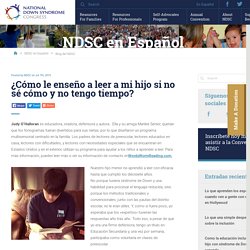
Judy O’Halloran es educadora, oradora, defensora y autora. Ella y su amiga Marilee Senior, querían que los fonogramas fueran divertidos para sus nietas, por lo que diseñaron un programa multisensorial centrado en la familia. Los padres de lectores de preescolar, lectores educados en casa, lectores con dificultades, y lectores con necesidades especiales que se encuentran en Estados Unidos y en el exterior, utilizan su programa para ayudar a los niños a aprender a leer. Para más información, pueden leer más o ver su información de contacto enWordyWormReading.com. Nuestr o hijo menor no aprendió a leer con eficacia hasta que cumplió los diecisiete años. Como Casey no cumplía con los plazos asignados por el distrito cuando ingresó en la secundaria, su escuela planeaba cambiarlo a un programa centrado en listas de vocabulario de supervivencia.
Entonces, ¿qué son los fonogramas? Logic of English - What Are Phonograms? Details.

Logic of English - Phonograms FAQs. This is a great question, because it gets at the heart of what a phonogram is.
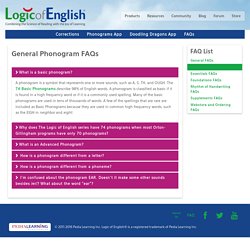
First, a key for those new to the LOE phonograms: The phonogram EA says three sounds: /ē/ as in lean, /ĕ/ as in bread, and /ā/ as in steak. The phonogram R says /r/ as in run and errand. The phonogram EAR says /er/ as in search. Now, for the question. In words like "learn" and "earn" and "search," the letters EAR are working together to say /er/. In the words "bear" and "wear," EA says its third sound, /ā/, and R says /r/.
A multi-letter phonogram is a group of letters working together to say a unique sound that they wouldn't say otherwise. While we are asked most often about EA+R, other letter combinations also appear sometimes as a multi-letter phonogram and sometimes as separate phonograms. Note: There is in fact one other unique sound of EAR, but it is so uncommon that we do not teach it as a basic sound of the phonogram.
Review: Essentials: Logic of English Complete Set and Phonics with Phonograms App. Logic of English - Systematic Phonics. Why you need to know your phonograms! Helping you understand Phonograms: By now you will have discovered that there are approximately 44 phonic sounds which make up our English Language. We need to be able to spell these sounds so that we can make words to read (where would we be without books!) - we refer to these cluster of letters as phonograms. Words with the same phonogram are often referred to as word families.
Untitled. How to Teach Phonograms: Part 3 This is the third and final installment of, “How to Teach the Phonograms.”.
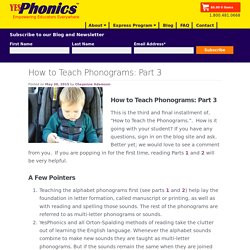
How is it going with your student? If you have any questions, sign in on the blog site and ask. Better yet; we would love to see a comment from you. If you are popping in for the first time, reading Parts 1 and 2 will be very helpful. Untitled. How to Teach the Phonograms Part 2 The phonograms, sound symbol relationships, are the foundational building blocks for spelling and reading.

In part one of this blog we concentrated on what we typically call the “circle letters” and why they are taught together and out of alphabetical order. Please glance through that article if you are seeing Part 2 first. Remember to practice each phonogram 5 times as prescribed; never in a rote way. This will not be enough for mastery, but it will be enough to move forward in the learning. Similar phrasing or dialogue can be found on pages 33 and 34 in the Yes Phonics Express manual. In addition to learning the alphabet phonograms, your students are also learning how to write. Download part 2 of the phonogram flash cards to begin. Free Phonogram Sounds App. It’s no secret that one of our favorite homeschool programs is All About Spelling from All About Learning Press.

Both their spelling and reading programs are ones we recommend for any family. Especially now that they have a FREE app that anyone can use to help with the pronunciation of some of those pesky phonogram blends! This week, All About Learning Press released a FREE phonogram sounds app for the iPad, iPhone/iPod, Windows, Android and Mac OSX {don’t worry, a Kindle app is coming soon!}. Use it on your computer, tablet devices, iPod and more! Phonogram Sounds App. Click a button and hear the correct pronunciation of the phonograms (letters and letter combinations) Designed to accompany All About Reading and All About Spelling The button colors match the colors of our Letter Tiles to reinforce learning Phonograms are arranged in logical groupings, matching the labels provided with the Letter Tiles You, as the teacher, can learn the pronunciations quickly and accurately before teaching your student.
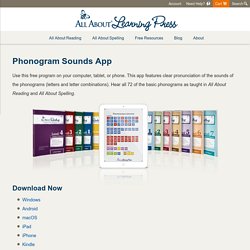
You won’t have to wonder if you are pronouncing them correctly—now you will know for sure! Your student can learn directly from the program. Give him several phonograms to learn at a time. After he has clicked on each phonogram several times, he will have a good idea of the sounds. Phonograms. What Are Phonograms? How to Teach Phonograms: Part 1 - YesPhonics. How to Teach Phonograms Part I.
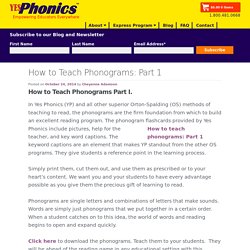
In Yes Phonics (YP) and all other superior Orton-Spalding (OS) methods of teaching to read, the phonograms are the firm foundation from which to build an excellent reading program. The phonogram flashcards provided by Yes Phonics include pictures, help for the teacher, and key word captions. The keyword captions are an element that makes YP standout from the other OS programs. They give students a reference point in the learning process. Simply print them, cut them out, and use them as prescribed or to your heart’s content. Phonogram Sounds. The Phonogram Sounds manipulative teaches a phonetic analysis and synthesis of alphabet letters and words.
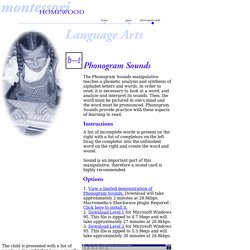
In order to read, it is necessary to look at a word, and analyze and interpret its sounds. Then, the word must be pictured in one's mind and the word must be pronounced. Phonogram Sounds provide practice with these aspects of learning to read. A list of incomplete words is present on the right with a list of completors on the left. Drag the completor into the unfinished word on the right and create the word and sound.
Sound is an important part of this manipulative, therefore a sound card is highly recommended. 1.